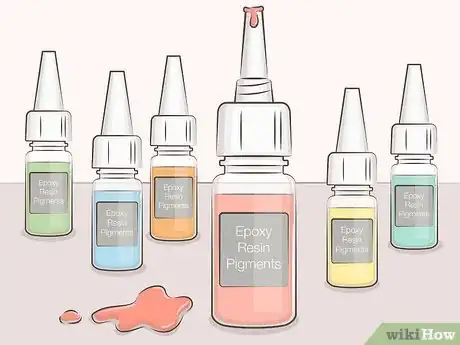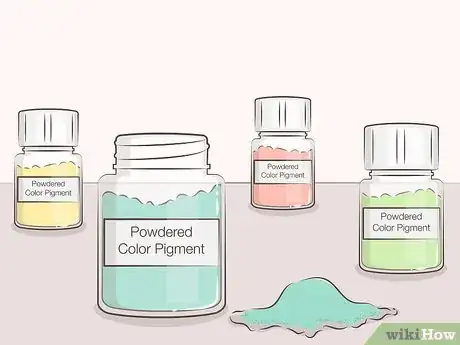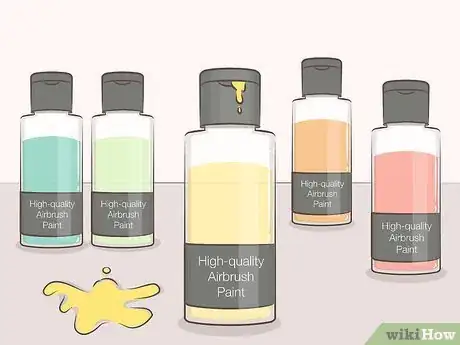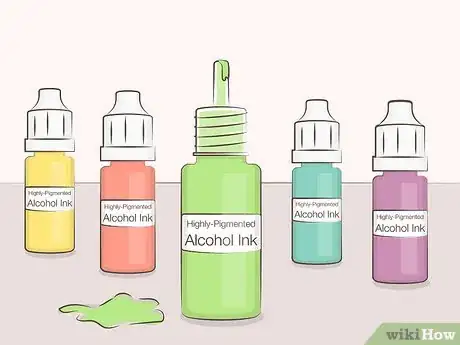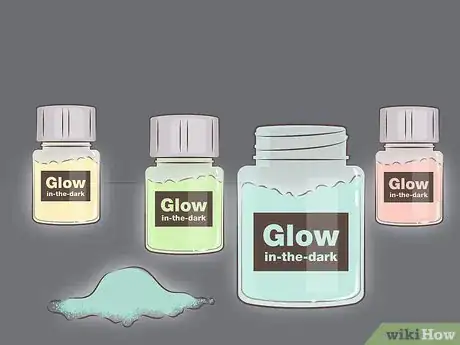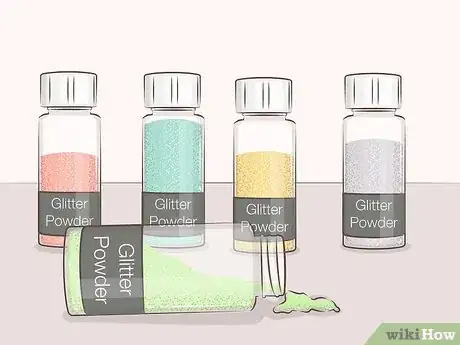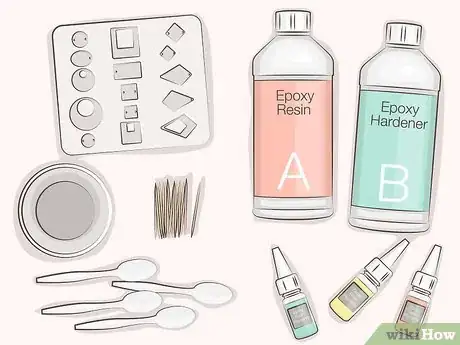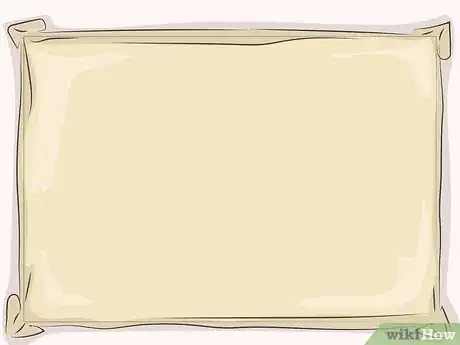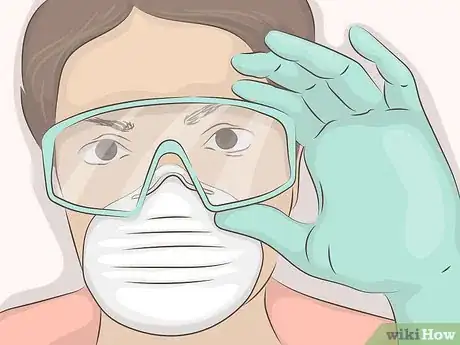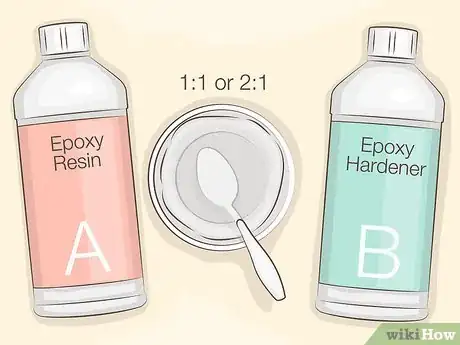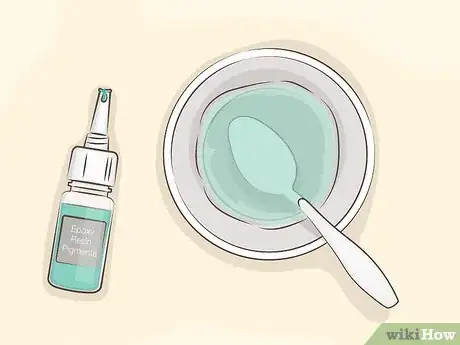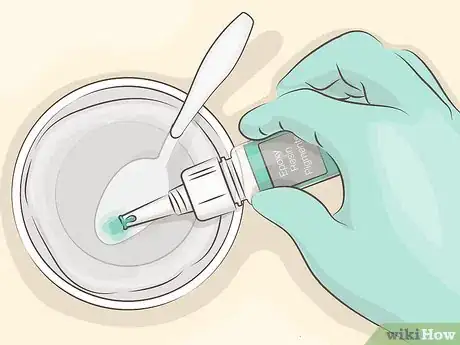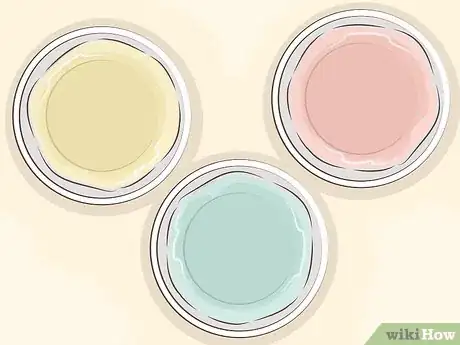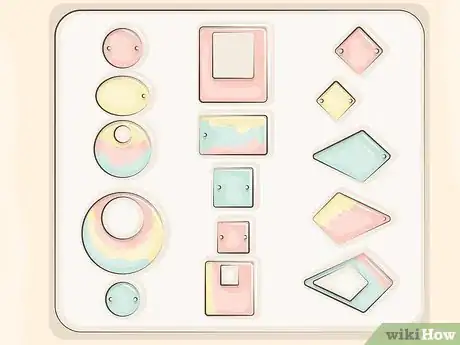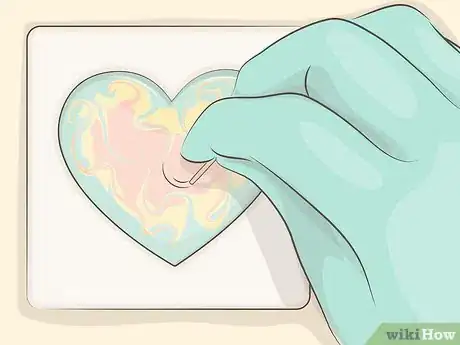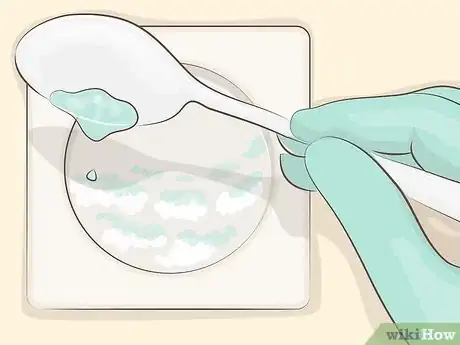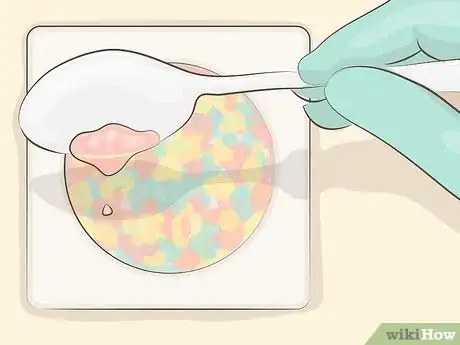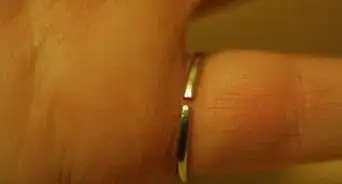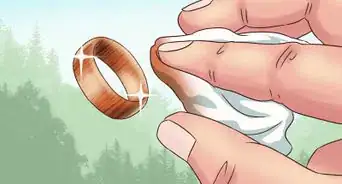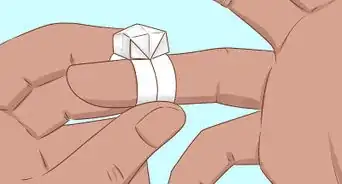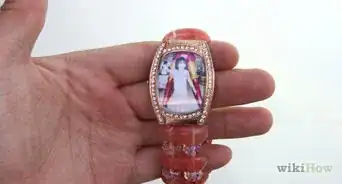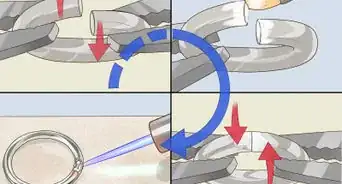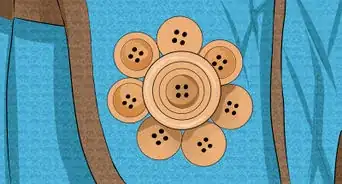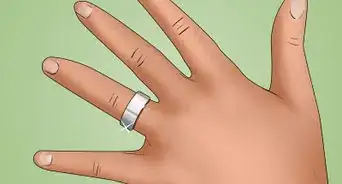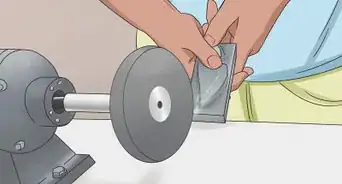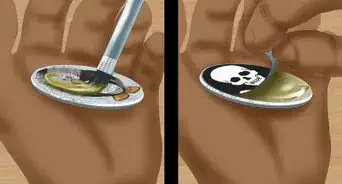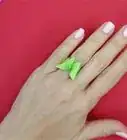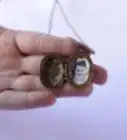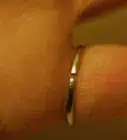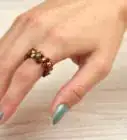This article was co-authored by wikiHow Staff. Our trained team of editors and researchers validate articles for accuracy and comprehensiveness. wikiHow's Content Management Team carefully monitors the work from our editorial staff to ensure that each article is backed by trusted research and meets our high quality standards.
There are 17 references cited in this article, which can be found at the bottom of the page.
This article has been viewed 14,386 times.
Learn more...
There are lots of different ways to color resin, so you’re bound to find a method that creates just the effect you’re looking for. In this article, we’ll walk you through the coloring options so you can pick the right one for your project, and we’ll teach you how to mix a batch of colored resin. Whenever you work with resin, make sure to wear goggles, a mask, and gloves to protect yourself from the fumes and chemicals.
Steps
Color Options
-
1Use epoxy resin pigments for solid, vibrant, easy-to-mix colors. This type of dye is formulated specifically for use with epoxy resin only (the most common type of resin for jewelry-making). You can mix batches quickly and get a beautifully bright result.[1]
- Find a variety of colors online or at your local craft store.
- It’s hard to say exactly how much pigment to add to how much resin because there’s no set formula for achieving certain shades or colors. Your best bet is to practice adding a small amount (a single drop or a similarly-sized amount of powdered pigment) to resin and adding more until you get the right shade.[2]
-
2Create an opaque, matte effect with powdered color pigments. This is a budget-friendly option since you need a super tiny amount of pigment to color a batch of resin. You might also see this powder marketed as “mica powder.”[3] Pigment powder works well with epoxy resin, and you can use it with UV resin, too.[4]
- A resin expert recommends making a “stock solution” with powdered pigments: take a small amount of resin and add the powdered pigment to it. Stir it up so it’s completely dissolved. Then, add that small batch back into the rest of the resin and mix it up. It’s easier to dissolve the powder this way.[5]
- While you should always wear a mask when working with resin, it’s especially important when using a powdered pigment—you don’t want to inhale any of the powder.
Advertisement -
3Make vividly-bright pieces of jewelry with high-quality airbrush paint. If you decide to use airbrush paint, don’t skimp on quality for a less-expensive product. Quality paints have a higher color concentration, which is especially important for resin jewelry. Airbrush paint works best with epoxy resin.[6]
- A great rule to follow is to add 1 part paint to every 10 parts resin.[7]
-
4Add highly-pigmented alcohol ink to pieces that won’t be worn often. Alcohol ink isn’t very light-resistant, so it’s not great for jewelry that will be worn frequently and get a lot of UV exposure. But, it can create a gorgeous piece that you save for special occasions. Plus, it takes just 2-3 drops of ink to color resin with bright, vibrant shades.[8] This method works well with epoxy resin.[9]
- Make sure you’re wearing gloves while you use alcohol ink! It will absolutely stain your hands and anything else it gets on.
-
5Opt for luminous pigments to create cool glow-in-the-dark jewelry. These are also marketed as “glow powders.” The shades normally look pretty opaque in the daytime but then glow bright when it gets dark.[10] These types of pigments work with all kinds of resin, though epoxy is generally the best for jewelry.[11]
- Your best bet to find this type of pigment is online. Some craft stores might carry it, but call ahead to check that it’ll be in stock.
- Mix 1 part pigment to 10 parts resin to start, and add more if you want a deeper color. Adding too much pigment can make your resin clumpy.[12]
-
6Mix glitter powder with resin to create jewelry that sparkles. Glitter doesn’t color the resin by itself, but you can combine it with a coloring option. For evenly-distributed sparkles, opt for super-fine glitter. Use larger pieces of glitter for a more exaggerated effect. Or, carefully place individual pieces of glitter to create a specific pattern. Glitter works with all kinds of resin.[13]
- Since making jewelry is an art, the best way to find out what works best is to experiment. You’ll get different effects from simple adjustments to ratios and kinds of color.
- With glitter, you can add as much as you want, as long as its total volume doesn’t make up more than 6% of the mixed resin. Adding too much will mess up the finish.
The Jewelry-Making Process
-
1Gather all your materials so you don’t have to stop mid-project. Resin hardens and cures very quickly, so you won’t have a ton of time to mix colors and grab equipment once you start working. Here are some things you might want to have nearby:[14]
- Molds
- Resin and hardener
- Coloring options
- Disposable cups and spoons
- Toothpicks
-
2
-
3Keep yourself safe by wearing goggles, a mask, and gloves. You don’t want to breathe in the fumes from the resin, and you don’t want to risk something splashing in your eyes. You might feel like you look a little silly all geared up, but it’s better to be safe than sorry.[17]
- By gloves, we mean rubber or disposable gloves, not the kind you wear in the winter.
-
4
-
5Test your coloring option on a small amount of resin. Pour a little bit of resin into a disposable cup or paper plate, then mix in a tiny amount of the color you want to use. Stir them together, and check that the effect is what you want. This step can save you a lot of time and frustration![20]
- This can be especially helpful if you’re not sure of the color of a particular pigment or if you want to try mixing multiple colors.
-
6Mix a batch of colored resin, adding a single drop of color at a time. The key is to mix each drop in thoroughly before adding another to get the perfect shade.[21]
- Check out the last section of this article for techniques on making different patterns in your jewelry.
-
7Make as many batches of colored resin as you need. Use a separate disposable cup for each color. Follow the drop-at-a-time mixing process and combine the elements with a toothpick or small wooden stick.[22]
- Remember to use a new toothpick for each color.
-
8Pour and cure your resin molds to create beautiful pieces of jewelry. Use multiple colors of resin to create lovely swirls and designs, or create stunning minimalistic pieces out of stand-alone shades. Always consult the resin instructions to confirm how long the resin needs to cure.[23]
- If you’re not using silicone molds, spray them with a mold-release product. With it, your jewelry will pop right out of the container once it has cured.[24]
- It usually takes 24 hours before a piece is cured.
- Consider covering your molds with a domed lid while they cure to protect them from dust.[25]
Fun Patterns
-
1Create a beautiful marbled effect by swirling multiple colors. For this pattern, use clear resin and colored resins. Let the clear resin sit for 10-15 minutes until it has a syrup-like consistency. Pour a layer of clear resin into a mold, then add various-sized drops of colored resin. Use a toothpick to swirl the colors together for the marbled look.[26]
- The syrup-like consistency is very important! If the clear resin is really thin, the colored resin will bleed into it and won’t retain any shape.
-
2Make a fun cloud effect by dripping color directly into clear resin. For this method, you need clear resin and colored resins. Pour a layer of clear resin into a mold, then add multiple drops of colored resin. Use several different colors so the effect is really visible.[27]
- For example, use white resin and 2 shades of blue resin to create a realistic-looking cloud in your jewelry.
- Or, use different colors for a more vibrant, eclectic approach.
-
3Work in layers to create a stunning camouflage pattern. Mix 2-3 colors for the first layer, and choose a single color for the second layer. For the first layer, add multiple drops and streaks of color to the mold, leaving some space uncovered. Let that layer cure, then add the second layer of a contrasting color to finish the piece. For example:[28]
- Use black, brown, and white on the first layer to make the drops and streaks.
- Try not to let the first layer completely cover the bottom of the mold.
- Use green resin for the second layer after the first one cures. It’ll look lovely peeking through the other colors and will give your piece that traditional camouflage look.
Things You’ll Need
Mixing Resin and Color
- Molds
- Mold release
- Resin
- Hardener
- Coloring options
- Disposable cups and spoons
- Toothpicks
- Domed lid
- Plastic sheet
- Goggles
- Mask
- Gloves
References
- ↑ https://acrylgiessen.com/en/how-to-color-resin/
- ↑ https://youtu.be/gmyFmg6h-30?t=238
- ↑ https://youtu.be/y-tVBFZrR9o?t=208
- ↑ https://resin-expert.com/en/how-to-color-resin
- ↑ https://youtu.be/dbN4YTIFkgA?t=38
- ↑ https://resin-expert.com/en/how-to-color-resin
- ↑ https://www.resinobsession.com/resin-art/resin-painting-additives/
- ↑ https://resingeodes.wordpress.com/2018/04/24/what-can-you-use-to-color-resin/
- ↑ https://resin-expert.com/en/how-to-color-resin
- ↑ https://youtu.be/y-tVBFZrR9o?t=357
- ↑ https://resin-expert.com/en/how-to-color-resin
- ↑ https://www.resinobsession.com/resin-art/resin-painting-additives/
- ↑ https://youtu.be/y-tVBFZrR9o?t=398
- ↑ https://acrylgiessen.com/en/how-to-color-resin/
- ↑ https://acrylgiessen.com/en/how-to-color-resin/
- ↑ https://fluid-painting.com/en/resin-color-guide/
- ↑ https://fluid-painting.com/en/resin-color-guide/
- ↑ https://acrylgiessen.com/en/how-to-color-resin/
- ↑ https://resin-expert.com/en/guide/how-to-mix-epoxy
- ↑ https://fluid-painting.com/en/resin-color-guide/
- ↑ https://acrylgiessen.com/en/how-to-color-resin/
- ↑ https://fluid-painting.com/en/resin-color-guide/
- ↑ https://acrylgiessen.com/en/how-to-make-resin-jewelry/
- ↑ https://craftingintherain.com/resin-cat-earrings-and-necklace/
- ↑ https://youtu.be/InsHyvO0lNE?t=182
- ↑ https://youtu.be/InsHyvO0lNE?t=35
- ↑ https://fluid-painting.com/en/resin-jewelry-making/#Coloring
- ↑ https://fluid-painting.com/en/resin-jewelry-making/#Coloring
- ↑ https://liquidglassepoxyresin.com/how-to-color-epoxy-resin-with-paint-and-pigment/
- ↑ https://liquidglassepoxyresin.com/how-to-color-epoxy-resin-with-paint-and-pigment/
- ↑ https://acrylgiessen.com/en/how-to-color-resin/
- ↑ https://acrylgiessen.com/en/how-to-make-resin-jewelry/
